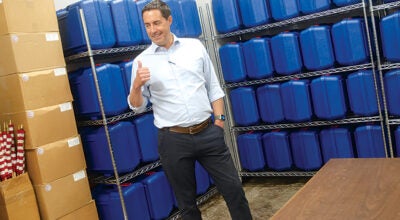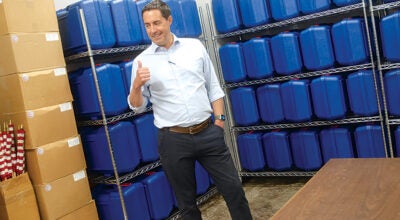The battle over mold
Published 12:00 am Sunday, July 3, 2011
Union group, Social Security Administration remain at odds over conditions at Ironton office
Both sides of a growing controversy continue to face off as to whether mold in a local government building is a health hazard.
After the union representing employees at the Social Security Administration’s Ironton office demanded that the facility be closed due to mold problems and was denied in November, the group has taken its concerns to the highest levels of government and whoever else will listen.
Last week, David Sheagley, president of the American Federation of Government Employees Local 3448, and Rick Hanna, vice president of the group, visited the Ironton SSA office, with some resistance. They contend nothing has been done to remediate mold growth in the office, which has resulted in nine out of 11 union workers filing individual worker’s compensation claims and a group grievance.
Sheagley said the workers have complained of eye, throat and respiratory irritations.
“They think, we think, it’s probably related to the spring time rains and the heat,” he said. “The mold is blooming again, it looks like.”
The two claim the agency has turned its back on the employees and are demanding answers as to why the problem persists.
Testing
Neither the SSA nor General Services Administration, which acts as the federal government’s real estate manager and leases space for the SSA, has denied that mold exists in the current facility, located at 405 S. Third St. But there is a debate between the two agencies and the union as to whether the mold is causing an unsafe work environment for employees and posing a danger to the public.
In November, when AFGE called for the office to be closed, SSA said there was no evidence to support the union’s claims that the black mold was harmful. Mold was first noticed by employees in the summer of 2009 and testing was performed in September 2009, and August and November 2010, and each report stated there was visible mold at various locations, including at wallpaper seams.
An indoor air quality survey report was requested by the SSA and was performed on Sept. 15, 2009, by Dennis Bridge of the Federal Occupational Health Agency.
Findings from that report indicated that suspect mold was observed behind wallpaper at the bottom corners of most of the windows in the south portion of the office, a window in the break room, at wallpaper seams and a musty odor was present near where the mold was observed.
The report made recommendations to seal areas of wallpaper where the mold was visible and to determine the extent of the mold within the office.
There was also a follow-up report done by Bridge in August of 2010. It stated, “Conditions of the office remain essentially the same as in September 2009.”
The report stated the areas with suspect mold had been covered with clear tape, but “no attempt had been made to investigate the extent to which mold had proliferated beneath wallpaper or in wall cavities.”
The tests done in November sampled mold in the air and found that the results, independent of visual observations, were not suggestive of an indoor growth condition.
Gail Montenegro, regional public affairs officer for the GSA, said the issue has been taken seriously.
“GSA has worked with the current lessor to ensure that appropriate measures are taken to contain the mold and prevent any spores from entering the air until SSA vacates the premises. These steps include encapsulating the mold in plastic, caulking the windows, and regularly checking and changing the air filters of the HVAC units. According to a study commissioned by GSA this past November, the mold count in the outside air is actually higher than the mold count inside the building.”
However, the National Institute for Occupational Safety and Health issued a letter to SSA in December 2010 that the mold could be creating an unhealthy work environment.
“There is sufficient evidence to conclude that the Ironton building is suffering from problems that contribute to substantial mold growth,” the letter stated. “It is probable, based on these conditions, the occupant symptoms are due to this work environment.”
The letter also stated that covering the mold with plastic may actually increase humidity behind the wallpaper, promoting an increase in mold growth. NIOSH also does not recommend air sampling for mold because the spores cannot be interpreted with regard to health risk.
Carmen Moreno, SSA regional communications director, said the agency has continued to monitor the situation but has not found sufficient evidence to close the Ironton office.
“There is no safety issue. It is airborne mold. It is not posing a health risk,” Moreno said. “We are concerned not only with our employees but also the members of the public that Social Security services day to day.”
Another round of testing took place June 29 and the results may take a few weeks to process.
“Whatever that shows, we will address it accordingly,” she said.
SSA officials denied requests to speak with local manager Jeri Fields.
A new facility
The union leaders also have concerns about a new SSA facility that is under construction in Ironton. The construction began in September 2010 on the corner of Seventh and Vernon streets. The GSA initially estimated the completion date for the new facility to be sometime this summer.
The shell of the facility has been completed, but Sheagley and Hanna said no work has been done on the interior and no one has given an explanation as to why.
“Not only are they not remediating, they are not trying to make it better to get into the new space,” Hanna said.
Hanna and Sheagley suspect the apparent inactivity at the new facility may be because of a dispute between then union and SSA over the new floor plan. The two group’s plans were at an impasse.
“They have been adamant that they want this particular floor plan and after it went to impasse they came out victorious,” Hanna said. “So, fine, you won, you got what you wanted. The employees didn’t get what they wanted. Now why isn’t this building over there being done in the manner you wanted? We are no longer any type of anchor on this.
Give us some rationale.”
GSA representatives say the project is on track.
“This project is moving forward and we are looking at a targeted completion date of late October or early November,” Montenegro said. “The final floor plan was approved and the new landlord is currently pricing out the construction based on the approved floor plans. Once GSA approves the landlord’s tenant improvement cost, we will give a notice to proceed to complete construction. Upon completion of this project, SSA employees will have the use and service of a beautiful new facility.”
Regardless, the union remains concerned the current construction inactivity will delay the fall deadline as well.
“If they are not ready to pick construction back up again, are we looking at December, or next April or what?” Hanna said.
Taking the concern to Capitol Hill
Sheagley and Hanna said they would use every avenue available to make sure employees at the Ironton office have a safe and healthy workplace.
“We’re going through our congressman. We’re going through the senators. We’re doing our grievance process within the agency. We’re also going to file with the Federal Labor Relations Authority an unfair labor practice,” said Hanna. “We are also encouraging our employees, who are private citizens and taxpayers too, to file a presidential inquiry on the White House website.”
Before Sheagley and Hanna toured the Ironton office last week, they said they were met with some resistance, even though they were contractually allowed to be there as members of the union. Having plans to file a group grievance with the union workers, they wanted to take photos as evidence to support their claim.
“We were not allowed to take pictures in the office,” Hanna said. “Chicago has refused us permission. Not only are you keeping people in there, you are also limiting our ability to represent them and get them out of there.”
The two had invited Sen. Sherrod Brown and Rep. Bill Johnson to tour the office with them, but were told they had to file a request with the regional office in Chicago.
“When you start seeing emails that come from the regional commissioner’s office saying that local politicians are not allowed to come into the building unless they get hold of the public relations office in Chicago, that’s unheard of,” Hanna said. “I’ve never, ever heard of them trying to keep any type of politician or elected official or anything like that (out).”
Brown and Johnson were permitted to tour the facility, but due to scheduling conflicts, they were unable come to Ironton.
Danielle Nemeth, field representative for Brown, has been involved with the situation since last year.
“I went down there last fall and I was just amazed at how much mold there was in the building,” she said. “They described the situation to me but nothing prepared me for actually going in the building… Our office has been involved in contacting GSA on behalf of the employees to try to get something done about the current situation.”
Brown agreed that something had to change.
“It’s unacceptable for Ohioans to risk their health and safety simply by going to work each day,” Brown said in a prepared statement. “These workers deserve fair treatment and I will continue to work to ensure safe conditions for the employees and the public.”
Rep. Johnson’s office, however, agreed with the SSA.
“The Social Security Administration has determined, after three rounds of tests in June and August of 2009 and November 2010, that there are no health concerns present in the Ironton office,” said Jessica Towhey, spokesperson for Johnson, in a prepared statement. “It is our understanding that a fourth round of tests will be performed (June 29). At the same time, the Social Security Administration continues construction on a new office and hopes to take occupancy in November.”
The National Field Council on Health and Safety met last week in Washington, D.C., and the issue of the Ironton office was discussed.
Howard Egerman, the national Health and Safety representative for AFGE, shared the concerns with members of the Office of Environmental Health and Safety.
“Our concern was that the employees are still in the office and what was mentioned at the meeting was… that they felt that the wallpaper acted as a barrier to the mold in the wall,” he said.
Egerman also filed a complaint with the Occupational Safety and Health Administration and sent a letter to the commission of Social Security, Michael Astrue.
“What management is required to do, is two things,” Egerman said. “For us as employees, (provide) a safe and healthy work place. And for public, a safe place to take care of their Social Security business. We feel that is not the case in Ironton.”
OSHA replied to Egerman’s request, but denied to conduct an inspection because “OSHA does not have a standard that addresses mold.”
OHSA’s letter to Egerman also said suggestions on how to address mold in the workplace were sent to SSA.
But the union said they are still willing to take their concerns even higher if necessary.
“We’re not backing off of this,” Hanna said. Whatever it’s going to take. I don’t care if we have to go up to Obama’s office before it’s over. You’ve got to do what’s right for the people.”
Hanna and Sheagley said they plan to return to Ironton to picket the current office.





